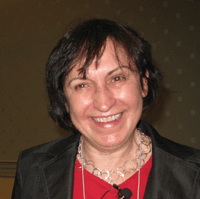Education at the Interface Between Mathematics and Materials Science
July 23, 2010

Panelist Carme Calderer pointed to problems affecting interdisciplinary education at all levels: Where in the curriculum is space to be found for work in application areas? Calderer also gave an invited talk (�Gels and Microfluidic Devices�) at the conference.
Maria Emelianenko discussed her experience in mentoring undergraduates in materials-oriented research projects through NSF-sponsored REU and CSUMS programs at George Mason University. See her article in this issue for examples of her students' projects, and for a discussion of how those projects influenced the students' careers.
Kaushik Bhattacharya argued that classes meant mainly for students in other disciplines should nevertheless present "real math." For example, a PDE class for engineers and physicists should not rely mainly on separation of variables, and a calculus class should not over-emphasize the tricks used to compute various integrals. Instead, we should try to communicate the power of mathematics---such as its ability to address problems that don't have explicit solutions.
Michael Brenner argued that discovery through computing can be a powerful educational tool, even for basic-level mathematics classes. In our research, we often use numerical methods to explore what's true before trying to give an explanation or proof. Our undergraduates should share the pleasure of such discovery, and the special type of insight it produces. This is possible even in relatively low-level classes like calculus and linear algebra.
Asked (in advance) to identify topics in statistical mechanics that should be taught to PhD students working at the math/materials interface, Weinan E arrived with two lists: recommended topics in statistical mechanics and in quantum mechanics. He pointed out that it's possible to make contributions in fluid mechanics---one of his fields---without knowing mechanics, whereas only those with some knowledge of fundamentals can make contributions in materials science.
Carme Calderer noted that the constraints and requirements imposed by many graduate programs make interdisciplinary study more difficult, by leaving little room for application-area courses such as physics, chemistry, or materials science. Jay Walton discussed how some of these obstacles have been overcome at Texas A&M in the context of an NSF-funded IGERT program, "Next-generation computational and analytical tools for materials science."
One member of the audience (Matthew Dobson) asked for advice on embedding examples from materials science in undergraduate classes. In the lively discussion that ensued, another audience member (David Kinderlehrer) suggested that answers might be found in undergraduate materials texts: Many of these books put the math "in colored boxes," he said, and such boxes often present examples of the desired type.
Overall, the panel and the audience agreed that this area is full of challenges---educational as well as scientific.---Robert Kohn, Courant Institute.

